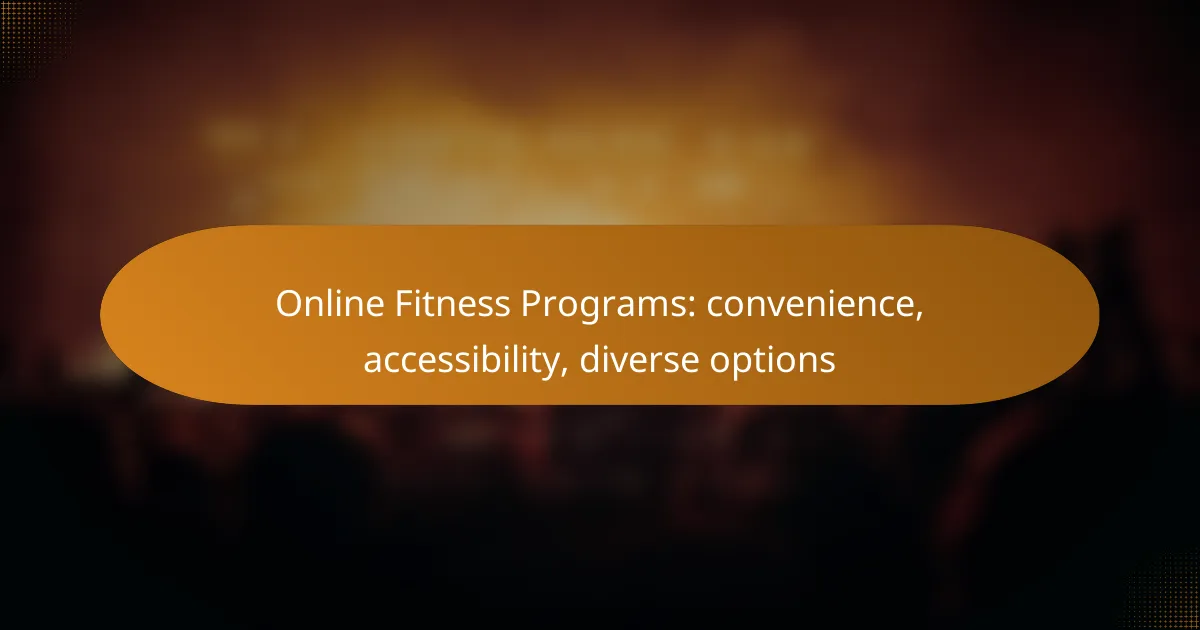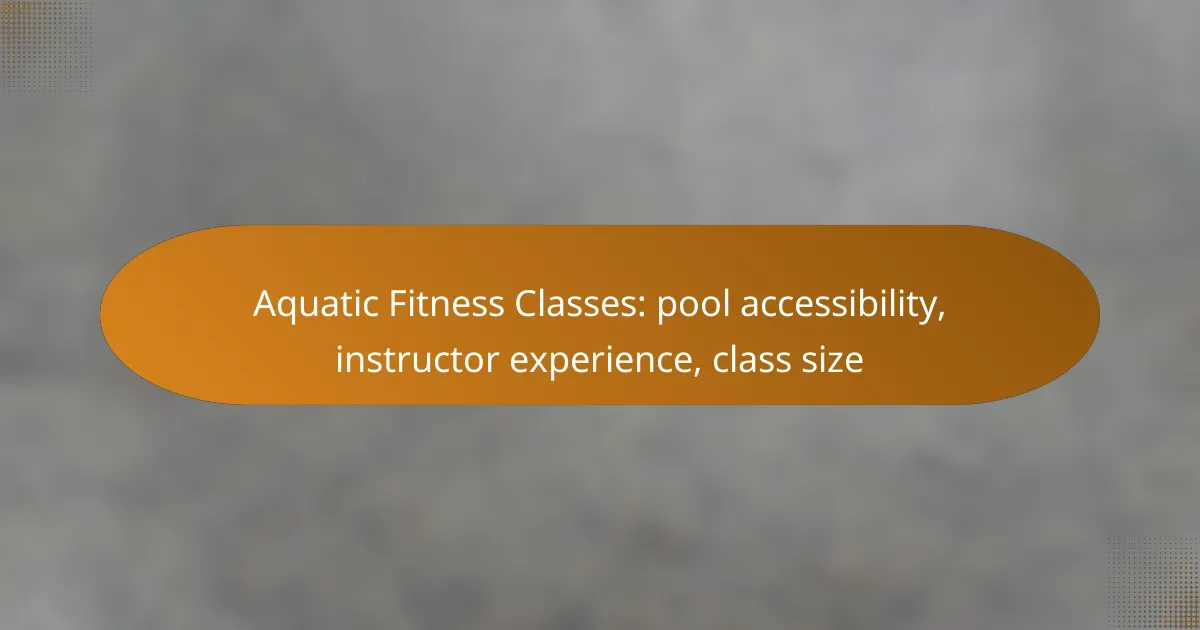Online fitness programs have revolutionized the way we approach exercise, offering unparalleled convenience and accessibility. With a diverse array of workout options available at any time and from anywhere, individuals can easily find routines that fit their unique preferences and fitness levels. This flexibility not only makes it easier to incorporate fitness into daily life but also encourages a broader audience to engage in healthier lifestyles.

What are the best online fitness programs for convenience?
The best online fitness programs for convenience offer flexible scheduling, a variety of workout types, and easy access from home or on-the-go. These platforms cater to diverse fitness levels and preferences, making it simple to integrate exercise into your daily routine.
Peloton Digital
Peloton Digital provides an extensive library of on-demand classes, ranging from cycling to strength training and yoga. Users can access workouts through the Peloton app on various devices, allowing for flexibility in choosing when and where to exercise.
Consider the subscription cost, which typically falls within the range of $12 to $20 per month, depending on the plan. Peloton also offers live classes, adding a sense of community and motivation for participants.
Beachbody On Demand
Beachbody On Demand features a wide array of fitness programs, including popular series like P90X and Insanity. The platform allows users to stream workouts anytime, making it easy to fit fitness into a busy schedule.
Subscriptions generally cost around $8 to $20 per month, with options for bundled nutrition plans. Beachbody also emphasizes a holistic approach, offering meal plans and support to enhance overall wellness.
FitOn
FitOn is a free fitness app that provides access to a variety of workout videos led by professional trainers. Users can choose from yoga, HIIT, pilates, and more, all designed for different fitness levels and preferences.
The app’s social features allow users to work out with friends, fostering accountability and motivation. While FitOn is free, premium features are available for a small monthly fee, enhancing the experience with additional content and personalized plans.

How do online fitness programs enhance accessibility?
Online fitness programs enhance accessibility by allowing users to engage in workouts from virtually anywhere at any time. This flexibility caters to various schedules and preferences, making fitness more attainable for a wider audience.
24/7 availability
One of the key features of online fitness programs is their 24/7 availability. Users can access workout videos, live classes, and training plans whenever it suits them, whether early in the morning or late at night. This constant access eliminates barriers related to gym hours or travel time.
For example, someone with a busy work schedule can fit in a quick workout during lunch breaks or after hours without worrying about gym closing times. This flexibility is particularly beneficial for those balancing work, family, and other commitments.
Adaptable workout levels
Online fitness programs often provide adaptable workout levels, catering to beginners, intermediates, and advanced users alike. Many platforms offer a range of classes that can be modified based on individual fitness levels, ensuring that everyone can participate and progress at their own pace.
For instance, a beginner might start with low-impact exercises while gradually incorporating more challenging routines as their fitness improves. This personalized approach helps prevent injuries and promotes a sustainable fitness journey.

What diverse options do online fitness programs offer?
Online fitness programs provide a wide range of options that cater to different interests and fitness levels. From yoga to high-intensity workouts, these programs allow users to choose formats that best suit their schedules and preferences.
Yoga and Pilates
Yoga and Pilates are popular online fitness options that focus on flexibility, core strength, and mindfulness. These programs often include various styles, such as Hatha, Vinyasa, or Power Yoga, and can be tailored to different skill levels, from beginners to advanced practitioners.
When choosing a yoga or Pilates program, consider the duration and frequency of classes. Many online platforms offer sessions ranging from 10 minutes to an hour, allowing for easy integration into busy schedules. Look for programs that provide clear instructions and modifications for different abilities.
High-Intensity Interval Training (HIIT)
High-Intensity Interval Training (HIIT) is designed to maximize workout efficiency by alternating short bursts of intense exercise with rest or low-intensity periods. These workouts typically last between 15 to 30 minutes, making them ideal for those with limited time.
When selecting a HIIT program, pay attention to the types of exercises included. Effective HIIT workouts often combine bodyweight movements, such as burpees and squats, with cardio elements like jumping jacks. Ensure the program offers modifications to accommodate various fitness levels and avoid injury.
Strength training
Strength training programs focus on building muscle and improving overall strength through resistance exercises. Online platforms may offer bodyweight routines, free weights, or resistance bands, catering to different preferences and available equipment.
To get the most out of a strength training program, consider your fitness goals and the equipment you have access to. Many online courses provide structured plans that outline sets, repetitions, and rest periods, helping you track progress. Aim for sessions that include a mix of compound and isolation exercises for balanced development.

What are the pricing models for online fitness programs?
Online fitness programs typically use two main pricing models: subscription-based pricing and one-time purchase options. Each model offers different benefits and considerations, allowing users to choose what best fits their fitness goals and budget.
Subscription-based pricing
Subscription-based pricing involves a recurring fee, usually charged monthly or annually, granting access to a library of fitness content. This model is popular for its flexibility, allowing users to explore various classes and instructors without a significant upfront investment.
Common subscription costs range from around $10 to $50 per month, depending on the platform and the variety of services offered. Many programs also provide free trials, enabling potential users to test the service before committing financially.
One-time purchase options
One-time purchase options allow users to buy specific programs or courses outright, often at a higher initial cost. This model is ideal for those who prefer a structured program without ongoing fees, making it easier to budget for fitness expenses.
Prices for one-time purchases can vary widely, typically ranging from $20 to several hundred dollars based on the program’s length and complexity. Users should consider the value of the content and whether it aligns with their fitness objectives before making a purchase.

How to choose the right online fitness program?
Choosing the right online fitness program involves assessing your personal fitness goals and evaluating program reviews. This ensures that the program aligns with your objectives and has a proven track record of success.
Assess personal fitness goals
Start by identifying what you want to achieve with your fitness journey. Common goals include weight loss, muscle gain, improved endurance, or overall health enhancement. Knowing your specific objectives will help narrow down programs that cater to those needs.
Consider your current fitness level and any physical limitations. For instance, if you’re a beginner, look for programs that offer foundational workouts and gradual progression. If you’re more advanced, seek out programs that challenge you with higher intensity and complexity.
Evaluate program reviews
Researching program reviews is crucial for understanding the effectiveness and reliability of an online fitness program. Look for testimonials from users who have similar goals to yours, as their experiences can provide valuable insights.
Check multiple sources for reviews, including social media, fitness forums, and dedicated review websites. Pay attention to comments regarding the program’s structure, support from trainers, and user engagement. A program with a high satisfaction rate and positive feedback is often a safer choice.

What are the benefits of live classes in online fitness?
Live classes in online fitness offer immediate interaction and personalized guidance, enhancing the workout experience. Participants can receive real-time adjustments and motivation, making workouts more effective and engaging.
Real-time feedback
Real-time feedback during live classes allows instructors to correct form and technique instantly, which can prevent injuries and improve performance. This immediate interaction helps participants stay aligned with their fitness goals and ensures they are executing exercises correctly.
For example, if a participant is struggling with a specific movement, the instructor can provide tailored advice on adjustments or modifications. This level of personalized attention is often lacking in pre-recorded sessions.
Community engagement
Community engagement is a significant benefit of live online fitness classes, fostering a sense of belonging among participants. Interacting with others in real-time can enhance motivation and accountability, as individuals feel part of a collective effort toward fitness.
Many platforms incorporate chat features or virtual group activities, allowing participants to share experiences and support one another. This social aspect can lead to lasting friendships and increased commitment to fitness routines.

How do online fitness programs compare to in-person training?
Online fitness programs offer a convenient alternative to in-person training by providing access to workouts anytime and anywhere. They cater to a wide range of fitness levels and preferences, making it easier for individuals to find a program that suits their needs.
Cost-effectiveness
Online fitness programs are often more affordable than traditional in-person training sessions. Monthly subscriptions can range from low single digits to low tens of USD, while personal trainers may charge significantly more per session. This cost difference allows users to access a variety of classes without a large financial commitment.
Additionally, online programs eliminate travel expenses and time spent commuting to a gym. This can lead to further savings, especially for those who live far from fitness facilities.
Flexibility in scheduling
One of the main advantages of online fitness programs is their flexibility in scheduling. Users can choose when to work out, fitting sessions into their busy lives without the constraints of gym hours or trainer availability. This is particularly beneficial for those with irregular work schedules or family commitments.
Moreover, many online platforms offer on-demand classes, allowing participants to select workouts that match their energy levels and time constraints. This adaptability helps maintain motivation and consistency in fitness routines.



